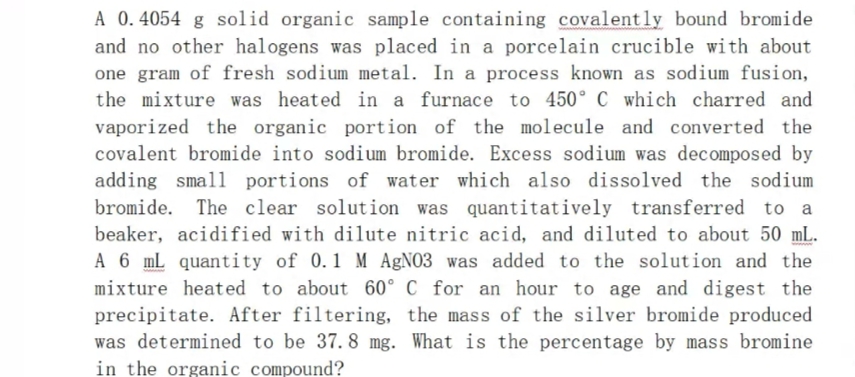A 0. 4054 g solid organic sample containing covalently bound bromide and no other halogens was placed in a porcelain crucible with about one gram of fresh sodium metal. In a process known as sodium fusion, the mixture was heated in a furnace to 450° C which charred and
A 0. 4054 g solid organic sample containing covalently bound bromide and no other halogens was placed in a porcelain crucible with about one gram of fresh sodium metal. In a process known as sodium fusion, the mixture was heated in a furnace to 450° C which charred and
Organic Chemistry: A Guided Inquiry
2nd Edition
ISBN:9780618974122
Author:Andrei Straumanis
Publisher:Andrei Straumanis
Chapter4: Polar Bonds, Polar Reactions
Section: Chapter Questions
Problem 4E
Related questions
Question
Please help thank you this is analytical chem

Transcribed Image Text:A 0.4054 g solid organic sample containing covalently bound bromide
and no other halogens was placed in a porcelain crucible with about
one gram of fresh sodium metal. In a process known as sodium fusion,
the mixture was heated in a furnace to 450° C which charred and
vaporized the organic portion of the molecule and converted the
covalent bromide into sodium bromide. Excess sodium was decomposed by
adding small portions of water which also dissolved the sodium
bromide. The clear solution was quantitatively transferred to a
beaker, acidified with dilute nitric acid, and diluted to about 50 mL.
A 6 mL quantity of 0.1 M AgNO3 was added to the solution and the
mixture heated to about 60° C for an hour to age and digest the
precipitate. After filtering, the mass of the silver bromide produced
was determined to be 37. 8 mg. What is the percentage by mass bromine
in the organic compound?
Expert Solution
This question has been solved!
Explore an expertly crafted, step-by-step solution for a thorough understanding of key concepts.
This is a popular solution!
Trending now
This is a popular solution!
Step by step
Solved in 2 steps

Knowledge Booster
Learn more about
Need a deep-dive on the concept behind this application? Look no further. Learn more about this topic, chemistry and related others by exploring similar questions and additional content below.Recommended textbooks for you

Organic Chemistry: A Guided Inquiry
Chemistry
ISBN:
9780618974122
Author:
Andrei Straumanis
Publisher:
Cengage Learning

Organic Chemistry: A Guided Inquiry
Chemistry
ISBN:
9780618974122
Author:
Andrei Straumanis
Publisher:
Cengage Learning